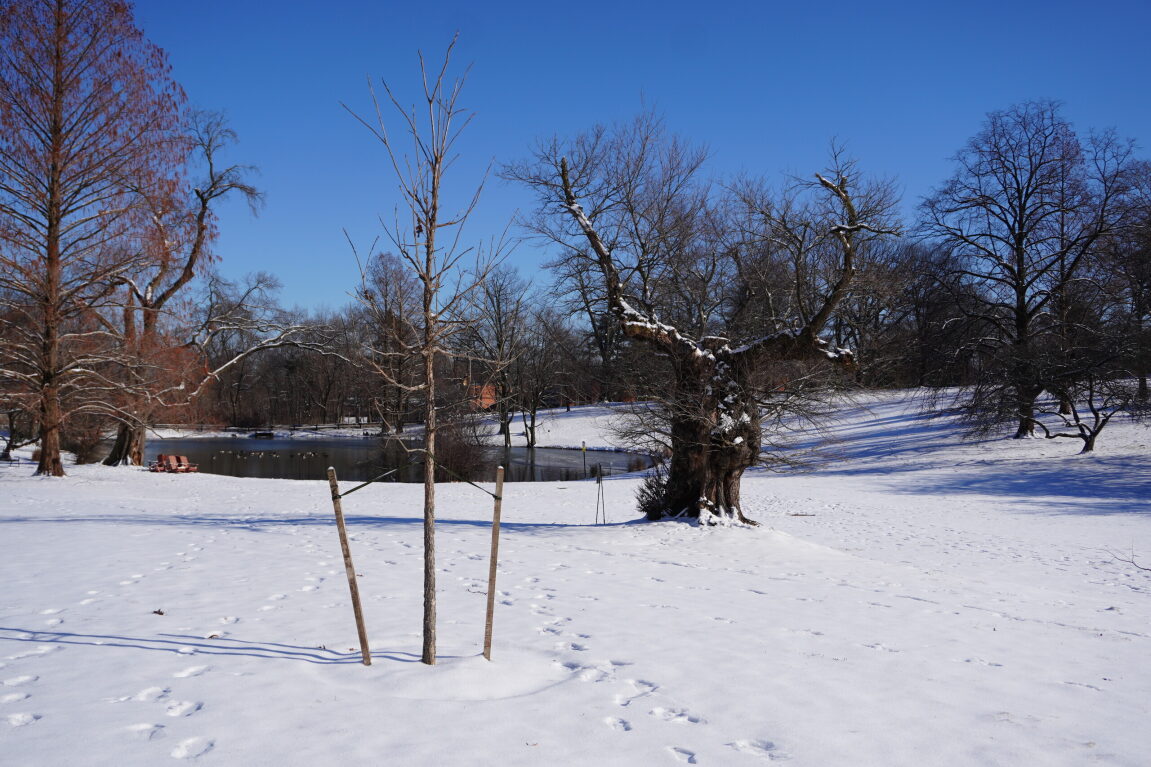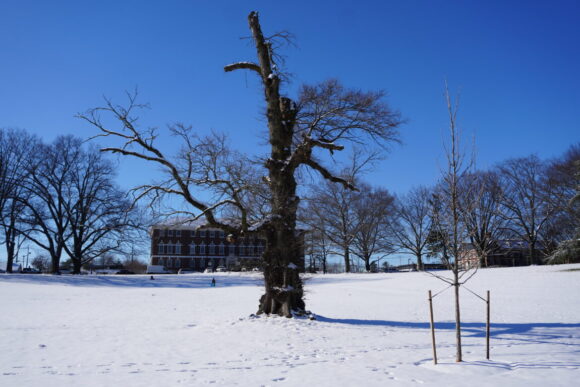
Dying elm tree at Passion Puddle to be replaced this spring. Photo: Victoria Cassiano.
Passion Puddle has served as the center of countless Ag Field Days, now Rutgers Day, and graduation ceremonies for generations of students on the Cook College campus. The lawn surrounding this beloved pond provides a relaxing place to study, relax, or people-watch on many a warm spring or fall afternoon. It is, quite simply, the emotional heart of the campus.
So, any changes to this beloved space are bound to generate immediate interest among those who enjoy its shady, green expanse. Most notably, two elm trees on the lawn around Passion Puddle are slated to be removed. In addition, several new plantings dot the immediate area around the pond.
These plantings, and the replacement of lost trees, can be seen as one of many steps to ensure a continued canopy presence on the lawn around Passion Puddle, according to Professor Jason Grabosky, the John and Eleanor Kuser Faculty Scholar in Urban and Community Forestry in the Department of Ecology, Evolution, and Natural Resources at the School of Environmental and Biological Sciences (SEBS) and Brian Clemson, University Landscape Architect.
Can you tell us why this is happening?
Grabosky: Well, as things go, the trees are in a state of decline. The two elms have served as a backdrop for the SEBS commencement exercises on the lawn. They have been used in the past for teaching and class discussion, and in their current condition we can still have discussions of elder tree care and decline. However, there have been concerns about folks’ perception of safety given large dead branches in the remaining canopy. Folks are concerned about setting equipment or staging people in the drop zones of the trees. One might argue the trees are no longer serving their designed purpose as teaching examples of their species or framing the space in the lawn.
Ok, so the trees are coming down?
Clemson: Well yes, but that is only part of the story. We are working to develop a long-range tree planting plan that is intended to address the inevitable loss of the large Red oak trees that line Lipman Drive and Red Oak Lane. As part of the recent tree planting effort, two Bur oak trees were planted near the existing declining elm trees.
We caught sight of new plantings in the adjacent Red Oak Lane.
Clemson: Yes, a total of 24 trees were planted in and around the Passion Puddle area this past fall. The trees were part of the Lipman Drive bus stop project and intended to replace six Red oak trees that were removed to accommodate the bus stop improvements. Additionally, some replacement trees have been planted in the area from other facilities projects. We view the area as an incredibly important space given the central campus location and the fact that our community events and graduation ceremonies occur in the space.
Grabosky: We’re working on replanting efforts to address the loss of trees in the area, specifically the Northern red oaks that are succumbing to Bacterial Leaf Scorch. Our goal is to begin canopy establishment before we need to remove the large trees, to enable a less jarring transition as the current trees leave the inventory. This year’s effort is only part of a longer plan, to manage the transition of the tree canopy on campus.

One of the dying elm trees on Passion Puddle. Martin Hall is in the background. Photo: Victoria Cassiano.
Why did you choose Bur oak as a replacement rather than the same elm species?
Clemson: We selected Bur oak because they are indigenous to the region, can be very long lived, averaging 200-300 years. At maturity, they can be massive, measuring 60′ to 80′ in height and of equal spread.
Grabosky: Some of these trees replace lost teaching specimens and the Bur oak trees are part of that plan. We are making species choices based on teaching and site needs. The students developed campus tree inventories across all New Brunswick campuses to retain a diversity and a balance in our tree population. These plantings, and the replacement of lost trees, can be seen as one of many steps to ensure a continued canopy presence on the Passion Puddle area. Students have been working with Rutgers Facilities over the past years. The Scarlet oak by Waller Hall (2023) and the various hickory species like those by Martin Hall (2019) were planted by students for Arbor Day celebrations.
When will all of this take place?
Clemson: A tree removal company is on-call to remove the trees when the best conditions present themselves for safe removal as early as possible in this spring semester. Part of my role is to coordinate with Rutgers grounds crew and try to provide a few days of advance notice before the trees are removed.
Grabosky: A small team of faculty and Rutgers Facilities staff is also finalizing plans for tree plantings that’s expected to result in more than 300 trees being planted this spring semester on all campuses in New Brunswick, as well as on the Newark and Camden campuses. The trees range from small seedling stocks to 3-inch diameter trunk landscape trees. A group of students in the Forestry Club is working toward a “Tree Campus USA” designation, and we see this as part of their effort for a 2024 Arbor Day Celebration.
Any final thoughts on the replanting effort?
Clemson: Yes, replanting is an investment in our future. It works into our University Carbon Plan, our stormwater planning and ensures a special institutional space for students in future years.
Grabosky: I see this all as incredibly hopeful. Here we have Facilities and faculty working on a common purpose and vision for the future. While the loss of the elms is a sad event, the replanting and investments for establishing the future canopy before an inevitable loss is extremely hopeful. It is stewardship with a long view.

